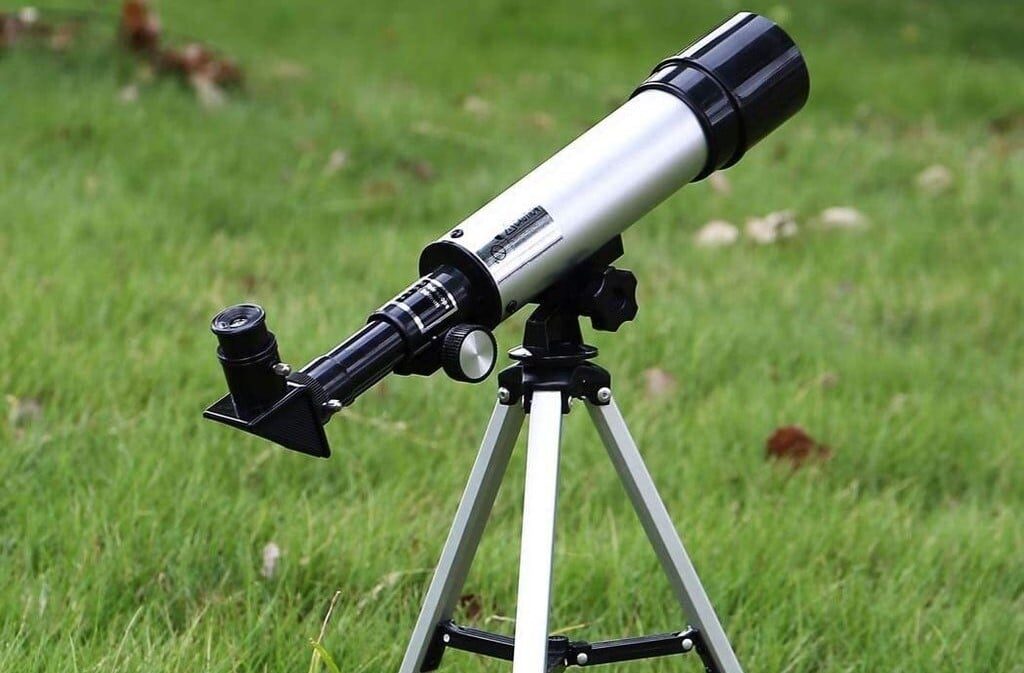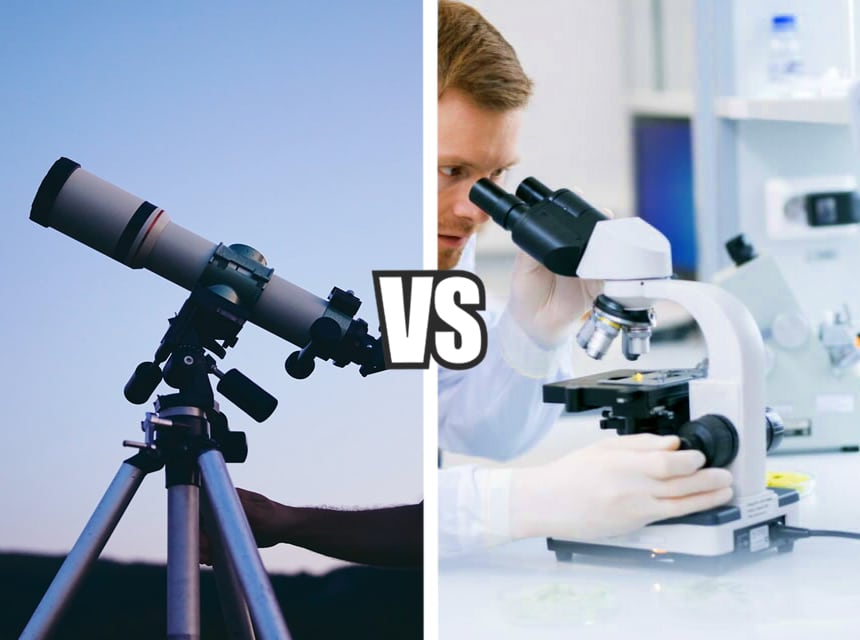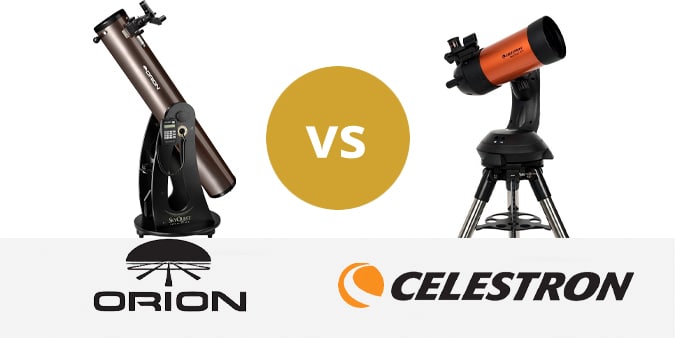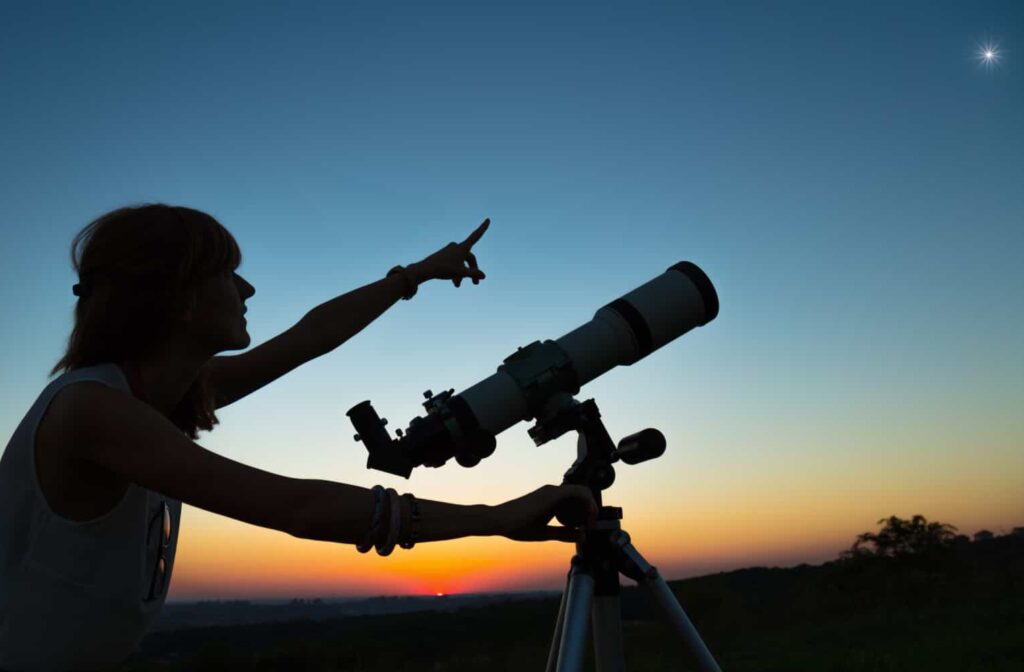

Exploring the world around us is a natural instinct, but while telescopes cover our curiosity in the sky, what shall we do on the land?
In this article, we’re going to take a look at a spotting scope vs telescope. You may not be familiar with spotting scopes, which is why we’ll break down the two objects and compare them in a way you’ll find interesting. We hope you can better understand the two viewing apparatuses and understand just what they are best used for. While there are many differences between a spotting scope and a telescope, they do have a similar construction, which will help you compare the two.
You are probably familiar with the shape of a telescope but perhaps not as sure about what is inside of one. At one end you will have an eyepiece that you look into. When you look into the eyepiece, your gaze will be directed through the body and then the objective lens. A telescope works by capturing the light from celestial bodies and filtering it through the objective lens.
The entire telescope rests on a tripod so that it is easier to look through the eyepiece. Furthermore, a tripod ensures you can keep your telescope steady so the small objects in the distance don’t become fuzzy.
Just keep in mind that there are different types of telescopes. Refracting telescopes use a system of lenses to focus light while reflecting telescopes use mirrors.
Telescopes Trusted Source How Do Telescopes Work? Early telescopes focused light using pieces of curved, clear glass, called lenses. However, most telescopes today use curved mirrors to gather light from the night sky. The shape of the mirror or lens in a telescope concentrates light. That light is what we see when we look into a telescope. spaceplace.nasa.gov are used to view distant objects, especially those in the night sky. While you will need different lenses to see further away, a standard telescope will allow you to see the moon and some close planets.
If you really want to, you can also use a telescope to see closer objects, such as mountains and other landscape areas.
Unfortunately, many beginner astronomers end up a bit disappointed with their first telescope. While there is no doubt you can see so much more with a telescope, you need a fairly powerful one to really see all the amazing sights of faraway galaxies. Furthermore, you need darkness and the glare from city lights often negates even the most powerful lenses.
Spotting scope has an eyepiece where an ocular lens is housed. You then look through the eyepiece where an image comes through the objective lens and is filtered through a system of prisms. There are focus dials to help you see objects closer.
Unlike a telescope that needs a tripod for mounting, a spotting scope is lightweight enough that you can hold it in your hands. However, there may be some instances where you will want to mount it on a tripod.
There are many uses for a spotting scope. You can view wildlife Trusted Source Wildlife Viewing Preparing for a stroll on a national wildlife refuge? We got you. www.fws.gov quite easily as it offers a higher magnification power than traditional binoculars. Hunters often bring spotting scopes with them to better see their targets Likewise sniping definitely requires the use of a spotting scope for better accuracy.
While you might be able to see the moon from your spotting scope, you won’t be able to see anything else in the sky.
Let’s dive into what makes a spotting scope and a telescope stand out from each other. Keep in mind what you think you want to use either for, and use that basis as a comparison. You just might find you need a different device than you first assumed.
The category of lenses can be a bit complicated because many people confuse it with the magnification power. While both numbers are connected, they are different. You will most likely see a series of numbers advertised, such as 40 – 130x. The first number, the 40, is the magnification number. Basically, it is 40 times the size of what an image would look like to the naked eye.
The second number in this case, the 130, refers to the size of the lens. The larger the lens means more light can be taken in through the scope. Thus, the picture will seem cleared.
A typical spotting scope will have a lens size of 60 to 80mm, although some have smaller or slightly larger measurements. A typical telescope will have a lens size of 60mm or 140mm.
You will often see this measurement referred to as the aperture. We know it can be a bit confusing but the more you interact with these numbers, the easier they are to understand.
Verdict – telescope
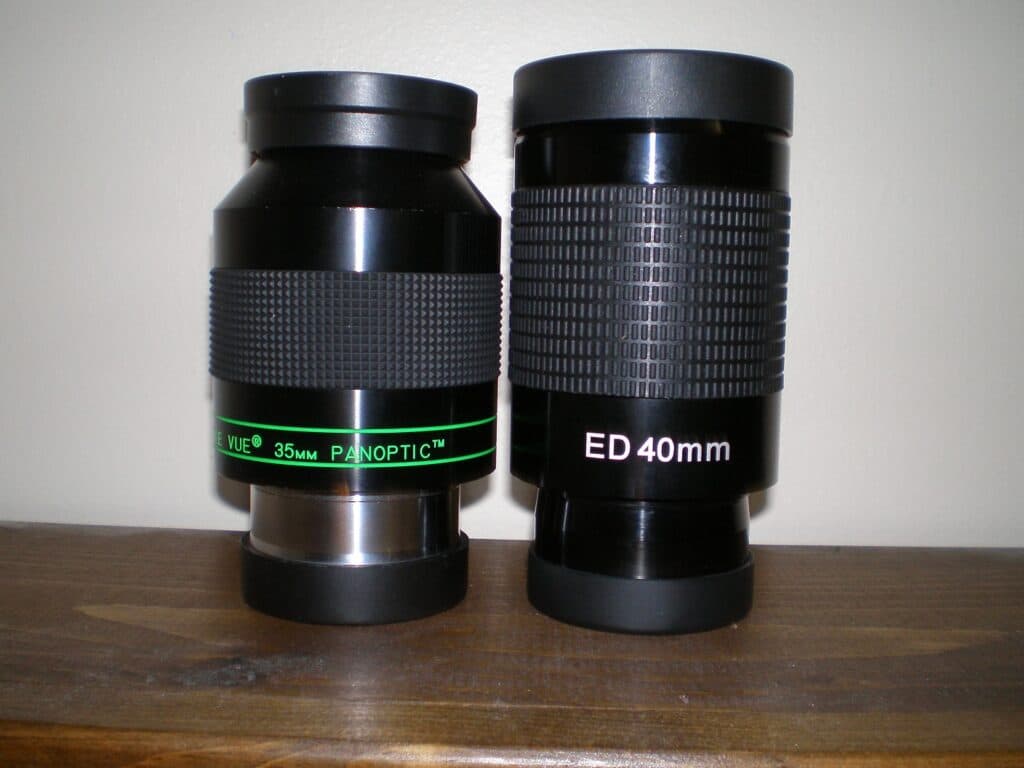
A spotting scope is meant to see birds close up in a tree or to scout out how far away that deer is you’re trying to hunt. As for a telescope, it is meant to peer into the skies above us.
Therefore, it should come at no shock that a spotting scope has a much smaller magnification capability than a telescope.
While all products will range in ability, expect a spotting scope to max out at 60x magnification. As for a telescope, the sky is literally the limit. If you are willing to pay a premium, you could find a telescope with a 150x magnification.
Those that want to see even more of the universe, you can find a product like the Galileo FS-80Z. This telescope has an impressive 120x magnification ability
A spotting scope will have more of a variability with its magnification ability, so you can zoom in as needed, up until the maximum magnification. This is essential as there can be a lot of variability between looking at a close-up tree and looking far away in the forest.
While you can zoom out or in with a telescope, you won’t have as much ability. Chances are you want to keep the zoom on maximum as everything is far away and you want to use your maximum magnification ability.
Verdict – Telescope
It can be a bit hard to compare prices between spotting scopes and telescopes because each device will have a wide range of products.
For a spotting scope, prices can range from around $100 to $1,000. As for a telescope, expect to pay between $200 and $3,000.
As an example, the Nikon Fieldscope 13-30x50mm is a premium product that comes in just over $800. With this price, you are getting a 30x magnification power, waterproof construction, and a bunch of accessories.
The magnification power is really what determines the cost of either a spotting scope or a telescope. Therefore, it’s important to know what you will be using either device for. If you just want an aid for birdwatching, you can pay a relatively small amount for a decent spotting scope.
In contrast, if you want to be able to see nebulae and faraway stars, you will have to pay quite a lot for a telescope that is powerful enough.
Verdict – Spotting scope
We mentioned earlier that a telescope is usually attached to a tripod. This is because you want a steady hand when viewing faraway objects in the sky and also because a telescope is too heavy to lift on its own. While you can find smaller, more compact telescopes perfect for travelling, the norm is to have a telescope set up in one area of your home that then doesn’t move.
As for a spotting scope, while you can choose to mount it to a tripod, it is also light enough to simply carry.
Furthermore, a spotting scope is made to be portable. It will often have a protective construction just in case it is scratched or is dropped.
Finally, a spotting scope is small enough to be carried in one piece. As for a telescope, it often needs to be taken apart and stored in two or three containers.
Verdict – Spotting scope
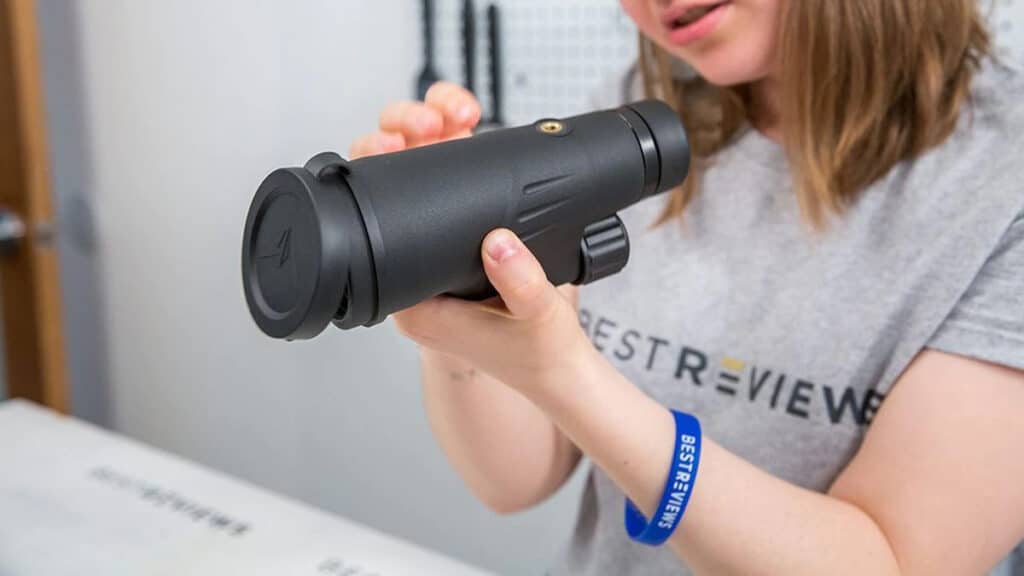
This can be a bit of a technical term, so we’ll try to break it down. With a field of view, we’re referring to how much you can see through a lens. For example, can you see just a single tree or will you be able to see the whole forest.
A spotting scope has a larger field of view than a telescope. This is because the magnification level is smaller, and therefore you can see more but not as close up.
In contrast, the field of view is smaller with a telescope because you need to be able to see farther distances, which narrows what you can actually see. This is why beginner astronomers get confused easily. They aren’t sure where they are looking at because they are only focused on one object.
Verdict – Spotting scope
This is a hard category to compare because spotting scopes and telescope have such different functions. You can focus on something, such as a bird, in much more detail with a spotting scope than with a telescope. However, you can see farther with a telescope and if you have a powerful lens, you can see it with much clearer focus.
A spotting scope is made to be able to focus on an object up to 6 feet in distance. You can use a spotting scope for neighborhood surveillance or perfectly spot if the wind is blowing around an animal target. Unfortunately, a telescope is not designed for these purposes.
Verdict – Spotting scope
How steady are your hands? There is a reason tripods were invented, and that is because no matter how hard we try, there will always be a slight tremor when holding an object.
A spotting scope can have a slightly blurry image quality to it, if only because of how we use them. So often spotting scopes are used when out on the move. As long as you hold steady, you won’t have a blurry image.
While there are portable telescopes, we often set these devices up at home on a tripod and therefore they are completely stable.
You can also use a tripod with a spotting scope. The difference is that you will probably be walking around with your spotting scope and therefore won’t want to stop and set up a tripod.
Verdict – telescope
You can use a spotting scope to look at the moon but you can’t use a telescope to look at birds. In other words, a telescope has the potential to be a bit more versatile.
However, we don’t want you to think a spotting scope will be able to match the power of a telescope. Far from it. You can’t see further away objects in the skies with a spotting scope.
The point is, though, that a telescope is too powerful for more ordinary tasks like birdwatching and hunting.
If you know you only want to see objects in the sky, go for a telescope. But, if you want to see nature in more detail, plus maybe get a closer view of the Man in the Moon, then a spotting scope is far more versatile.
Verdict – Spotting scope
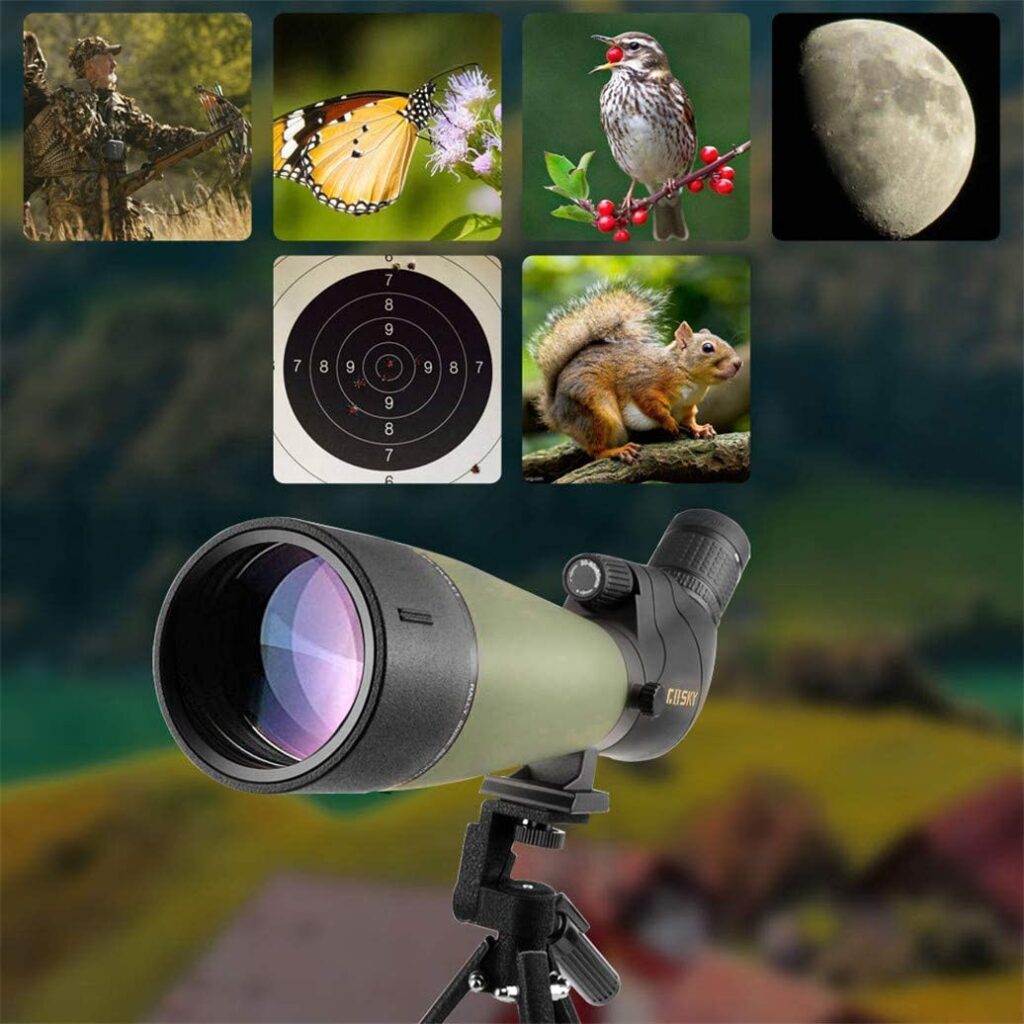
Having any sort of device that lets us see the world up close is truly a neat experience. There is so much to discover and unfortunately, our eye are just not up to the task. While a telescope is a familiar device, there are other instruments to consider, such as a spotting scope. While a telescope is meant for stargazing, a spotting scope can help us identify interesting birds, scope out our hunting targets, and even let us peer at the moon. You can find either instrument at an affordable rate but while spotting scopes generally max out at $1,000, telescopes can be found in excess of $3,000. There’s a lot to consider between a spotting scope vs telescope and we hope we’ve given you some interesting facts to consider. Whatever you choose, we commend your curiosity!
